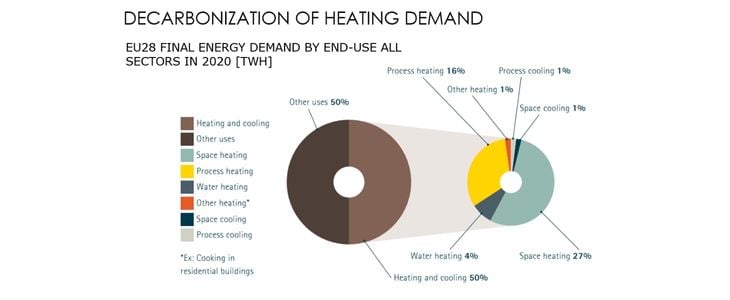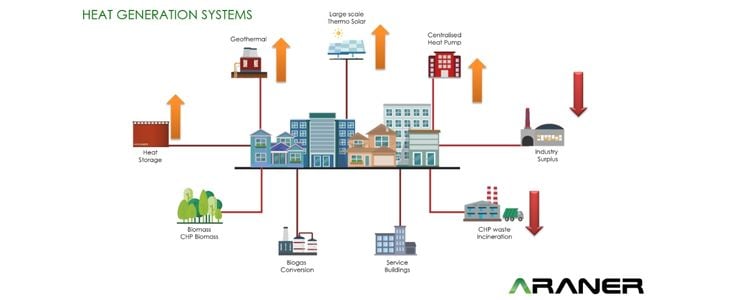The search for renewable heating can be defined as a hunt for efficient heating technologies that eliminate the reliance on fossil fuels and effectively achieve decarbonization.
As this quest continues, district heating systems stand out as a way to achieve 100% renewable energy systems that are also affordable, flexible and reliable. In fact, district heating production continues showing signs of growth, with heat production increasing 3% from 2020 to 2021, meeting nearly 8% of global final heating needs.
Throughout this article, we’re going to go through the different shapes renewable heating can take when district heating solutions are embraced.
This includes the incorporation of heat pumps: while this technology developed decades ago, it is now experiencing a robust comeback as more and more developers realize their potential for cost-effective, large-scale renewable heating systems. This is especially true as technology developments are allowing low-temperature energy sources to be increasingly considered as valid.
Keep reading to discover current energy solutions in renewable heating and the role of heat pumps and heat district systems to achieve them.
Renewable heating: why it’s important
Renewable heating stands at the heart of global decarbonization efforts, including the much-anticipated industrial decarbonization processes.
This is particularly true considering heating represents the largest energy end-use worldwide. In fact, heating accounts for around half of the total energy consumption. In other words, the global transformation towards 100% renewable energy systems must necessarily incorporate measures to achieve 100% renewable heating.
Today, much of the heating demand is met by using fossil fuel sources. This means air pollution and gas emissions are currently tied to heating technologies.
As governments, cities and economic players coincide in the importance of attaining renewable heating, the quest for reliable, sustainable sources continues. This is where district heating solutions paired with efficient industrial heat pumps come in.
District heating: an approach to achieve renewable heating
District heating comprises a series of technologies where heat is generated in a centralized location and then distributed through pipe systems.
Valid for both residential and commercial environments, district heating has been around for decades. Traditionally, energy sources for district heating involved the use of fossil fuels. In fact, most heat produced in this sort of technology still relies on these, while renewable sources represent just less than 8% of global district heating supplies.

The search for improved sustainability led to moving towards alternatives such as biofuels, an option which did not make the necessary impact in terms of decarbonization.
However, recent technological developments have meant other more sustainable heat sources can be considered, thus leading to great improvements in this option’s environmental impact. This involves a series of energy sources, including those that present low-temperature profiles, granted by the development of the 5th district heating generation. This new improvement means district heating systems are now able to work with temperatures that are close to ground temperatures: while previous models relied on delivering hot water at temperatures of around 80Cº, 5GDHC models are able to operate at around 50Cº.
This not only opens the door to the use of sustainable, renewable heating: it also helps in minimizing heat losses and the economic costs related to heating, especially relevant in a context of constantly-fluctuating costs.
The current situation regarding renewable heating is yet to tap into this system’s full potential in terms of decarbonization and renewable heating systems. In order to make the most of it, strategic plans and integrations must be implemented so that each project ends up developing the most adequate district heating solution.
In fact, scientific literature estimates that, in Europe, district heating (DH) will be able to provide at least 50% of the heat demands by 2050 in a cost-effective manner, building from the current level of 10%.
The role of heat pumps in achieving renewable heating
As we’ve mentioned above, district heating solutions can take many shapes and forms, some of which cannot be considered as renewable heating as they rely on fossil fuels. However, successful alternatives have already been implemented that employ renewable, sustainable energy sources, such as large heat pump systems.

Some of the current sustainable energy sources that are successfully being implemented in renewable district heating models include waste incineration, solar thermal district heating and geothermal district heating.
However, in this context, heat pumps stand out as one of the most efficient and cost-effective heating technologies today. This is due to a number of reasons:
- Their potential to incorporate sustainable, local and non-fuel heat sources, including groundwater, seawater, and waste heat
- The ensuing reduction in polluting emissions
- Their capacity to enhance low-grade heat to substantial heat. Modern developments have meant that highly-efficient heat pumps are now able to generate useful energy from locally-available energy sources. This includes 5th generation District Heating systems that reduce flow temperature supplies to around 60ºC, significantly improving a network’s efficiency; but also the possibility to employ ground source heat pumps as a state-of-the-art model that is currently facilitating modern renewable heating structures.
- Their energy efficiency, minimizing the amount of resources needed to generate energy. The concept of COP (Coefficient of Performance) arises when it comes to measuring heat pump efficiency. This formula measures the ratio between the heat output from the condenser (Q) to the power supplied to the compressor (W), thus providing an objective guide. Research confirms that industrial heat pumps are able to cut energy costs by one third, making these technologies reach unmatched COP efficiencies of between 3 to 6 units, as well as a 20% increase in heat recoveries.
All in all, the potential of combining district heating with heat pump technologies stands out as a model presenting a significant impact to reduce greenhouse gas emissions and incorporate renewable, sustainable energy sources to the heating equation.
Additionally, this leads to great improvements in a context where decarbonisation efforts are leading companies and developers to new territories where sustainability and efficiency are priorities.
At ARANER, we know that the future of heating will be renewable or it will not be. We speak from a decades-long experience in becoming the trustworthy, reliable partners for companies looking for sustainable and efficient energy technologies.
As such, we offer a wide variety of industrial heat pumps, as well as our expertise to develop end-to-end renewable heating solutions. Our working methodologies can involve developing custom heating solutions that take each project’s needs into account. From design to implementation and maintenance, we make sure each project ends up with the right energy solution that is also cost-effective and sustainable in the mid and long term.
Want to learn more about current renewable heating solutions and how district heating and heat pumps are enabling a new era of pollution-free heating technologies? We can help you.
Download our free District Heating ebook and our free technical guide for heat pumps and gain first-hand insights on the interconnection of these two heating technologies and structures and their role in the future of heating. You can also get in touch with us and speak to our team about your project and its specific needs.










